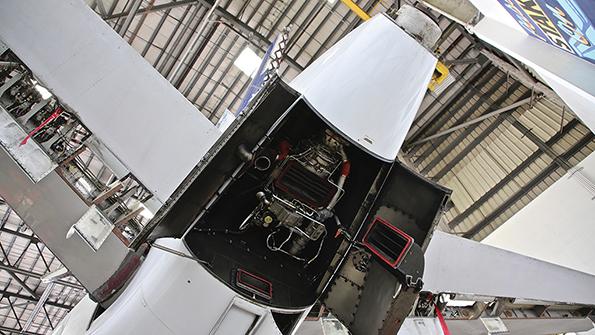MROへのより長く、より細いルートの影響

過去10年間、航空会社のフリート戦略における支配的な傾向は、ナローボディ航空機の大型化に向けられていました。 一方、航空機メーカーはシングル通路ラインの範囲を拡大し、低コストおよび他の航空会社が過去より長く細いルートおよび遠隔地市場を追求するための扉を開きました。
ノルウェーの大西洋横断サービスはその典型的な例であり、航空会社の財政は依然として不安定なままですが、他の航空会社もそれに続いています。 たとえば、JetBlue Airwaysは、エアバスA321neo航空機で大西洋を横断するフライトを開始する予定です。 この市場が発展するにつれて、MROが行われる場所に影響してきます。
ベースメインテナンス
これまで、ナローボディのベースメインテナンスは主に彼らの事業者の居住地域または大陸に限定されてきましており、米国の輸送業者はヨーロッパの格納庫を選択することはほとんどありません。 一方、「ワイドボディのメンテナンスは、主に人件費により、世界中どこでも発生します」と、AARの修理およびエンジニアリングサービスの上級副社長であるブライアン・サーテイン氏は言います。
ナローボディ重度検査の主な地域市場は、主にフェリーフライトのコスト、中短距離ネットワークでのメインテナンス場所の統合、場合によっては航空機自体の範囲です。
「航空会社の路線構造がほぼ安定しているため、ナローボディ市場はメンテナンスが行われる場所に関してほとんど変わらないことが予想されます」とサーテイン氏は言います。
SR Technicsのヨーロッパ販売担当副社長であるコナー・レーガン氏はこのポイントを支持しています。「中距離のMRO施設までのフェリーの飛行および機器のコストは経済的ですが、低コストのメンテナンスを確保するためにナローボディの航空機を航続距離の限界に向かってフェリー輸送することは、全く経済的ではありません。」
SR Technicsは、マルタに6ベイハンガーを備えたナローボディメンテナンス施設を建設しており、ヨーロッパ、中東、アフリカの顧客の興味を引くに適した場所にあります。
リトアニアに本拠を置くFLテクニクスのビリニュスは、通常3時間以内のナローボディの顧客を引き付けますが、 繁忙期には最大7時間延長可能です、とCEOのジルビナス・ラピンスカス氏は言います。「メンテナンスシーズンのスロットが不足しているため、より遠方の顧客を引き付けることができました」と彼は言います。
この重要なポイントは、他のメンテナンスプロバイダーからもわかるように、MROプロバイダーの選択は価格、品質、ターンアラウンドタイム、近接度だけでなく、キャパシティーによっても決まることを示しています。
「MROの容量がますます制限されているため、メンテナンススロットを確保するために長距離を移動する必要を避けるために、より多くの地域のプロバイダーと事前にスロットを予約する必要があります」とレーガン氏は言います。
しかしながら、逆のダイナミクスでは、新世代ナローボディは多くの場合、メンテナンス工数が少なくて済み、間隔が長くなります。「したがって、メインテナンスのために長距離を飛行することは、顧客にとって費用対効果が低い可能性があります」と彼は言います。
コンポーネントショップは、ナローボディの機体MROプロバイダーよりも遠方の顧客から修理の量を集めることができます。
ワイドボディでは状況が大きく異なり、グローバルルートネットワークと長いターンアラウンド時間により、航空会社は地理的に多様なメンテナンスプロバイダーを選択できます。
「アジアの低コストでワイドボディなメンテナンスプロバイダーが過去10年間にMRO市場に参入することで、APAC地域でのMRO活動の増加が見られました」とサーテイン氏は述べています。
とはいえ、アジアのプロバイダーの人件費の優位性が低下し続けているため、欧米の航空会社がワイドボディの重度メンテナンスを自国に近づけているという証拠があります。
ラインメインテナンス
ラインメインテナンスの性質により、顧客の近くで行う必要がありますが、いくつかのMRO企業は、新しい市場に施設を設立するか、外国のプロバイダーを購入することにより、この分野でのリーチを拡大しています。また、大抵の場合、ロービング航空機地上(AOG)およびモバイルメンテナンスチームを送るため、地理的範囲が広くなります。
「[ライとベースメインテナンス]ラインおよびベースメインテナンスを提供することにより、SR Technicsメンテナンスチームは、お客様の1人に対するAOGイベントの効果的な回復の重要性を認識し、より遠方のクライアントにサービスの品質を実証し、マルタの施設を検討することを奨めることができます」とレーガン氏は言います。
ラピンスカス氏は、モバイルチームとMROプロバイダーがより多くの顧客への対応できることに同意しますが、モバイルチームとその後の大規模な保守契約を直接結び付けることは困難です。
部品とエンジンメンテナンスe
「部品工場は、MROが地域内に確立された定期的かつ効率的な取引ラインを持ち、競争力のある信頼できるターンアラウンドタイムと相まって、より遠方の顧客からの修理を請け負うことが可能です」とレーガン氏は言います。
サータイン氏は、「グローバル市場」と言っているボックスやAPUなどの品目は例外であるものの、コンポーネントのメンテナンスは通常、航空会社の自社のオペレーション地域に限定されることに喚起しています。
これを促進する一つの傾向は、参加する航空会社が近くのディストリビューションセンターから交換部品を引き出し、プールに戻る前に古くなった部品を世界中の工場へ修理に送り出すプーリングプログラムの開発です
大抵のMROプロバイダーは、エンジン修理の市場がグローバルであることに同意しています。レーガン氏は、チューリッヒのエンジンセンターでSR TechnicsのCFM56およびPW4000メンテナンスサービスを全世界のグローバル顧客ベースに挙げています。
ラピンスカス氏は同意します、「エンジンのメンテナンスは、行う必要のある作業の範囲によって異なります。軽微な修理は、機上または近くでのメンテナンスを行う尾翼上もしくはその付近のメカニックパフォーマンスの駆動距離以内になります。主要な作業は輸送コストにそれほど敏感ではありません。 可用性、タイミング、所要時間、品質が主な要因となっています。」
繰り返しになりますが、最近の重要となっている要素は可用性です。新しい、より長距離の航空機と長距離のスプレッド、低コストのキャリアの普及はまだメンテナンス市場の境界線を引き直していないかもしれませんが、ハンガーとワークショップスロットの可用性は一部の航空会社を遠方のプロバイダーを利用する可能性があります」。
以上は、Alex DerberがInside MRO誌いた記事です。 Inside MRO誌は、民間航空機MROセクターの最新のトレンドとテクノロジーを調査しています。毎月の各号には、重要なテクノロジー、ビジネス、および運用上の意思決定に必要な情報が記載されています。さらに、加入者は月に1回発行されるAviation Week&Space Technologyを受け取ることができます。Aviation Week&Space Technologyは、業界をリードする最新の技術分析と洞察の情報源です。Inside MRO誌をもっと知りたい場合、こちらをクリックして下さい。
Over the past decade, the dominant trend in airline fleet strategy has been toward larger narrowbody aircraft. Meanwhile, aircraft manufacturers have extended the range of their single-aisle lines, opening the door for low-cost and other carriers to pursue more distant markets and longer, thinner routes than in the past.
Norwegian’s transatlantic services are a prime example, and while that airline’s finances remain somewhat precarious, other carriers are following in its wake. JetBlue Airways, for instance, intends to launch transatlantic flights with Airbus A321neo aircraft. As this market develops, it will affect where MRO is done.
Base Maintenance
To date, narrowbody base maintenance has been confined largely to the home regions or continents of their operators, with U.S. carriers very unlikely to choose European hangars and vice-versa. On the other hand, “widebody maintenance will occur anywhere globally, determined primarily by labor costs,” says Brian Sartain, senior vice president of repair and engineering services for AAR.
The primarily regional market for narrowbody heavy checks mainly is a function of the cost of ferry flights, a desire to coordinate maintenance locations with short-to-medium-haul networks and schedules and, in some cases, the range of the aircraft themselves.
“We expect the narrowbody market to stay largely unchanged in terms of where maintenance is provided due to the route structure of the airlines remaining largely stable,” says Sartain.
Conor O’Regan, vice president of sales for Europe at SR Technics, backs up this point. “Ferry flight and equipment costs up to mid-distance MRO facilities are economical, but ferrying narrowbody aircraft toward the limits of their range to secure lower-cost maintenance becomes much less economical.”
SR Technics is building a narrowbody maintenance facility with a six-bay hangar in Malta, well-located to attract customers from Europe, the Middle East and Africa, as well as “from farther afield for lease transitions,” says O’Regan.
Vilnius, Lithuania-based FL Technics usually attracts narrowbody customers within a 3-hr. flying time, but this can extend up to 7 hr. during busy periods, says CEO Zilvinas Lapinskas. “Slots in the maintenance season are scarce, which has led to us attracting clients from farther afield,” he says.
This important point, echoed by other maintenance providers, illustrates how the choice of MRO provider is not always dictated solely by price, quality, turnaround time and proximity, but also by what capacity is available.
“Increasingly limited MRO capacity sometimes is forcing customers to book slots well in advance with more local regional providers to avoid having to travel longer distances to secure maintenance slots,” says O’Regan.
However, an opposing dynamic is that newer-generation narrowbodies often require fewer maintenance manhours and allow longer intervals. “Thus flying longer ranges for maintenance events is less likely to be cost-effective for customers,” he says.
Component shops can attract repair volumes from more distant customers than narrowbody airframe MRO providers.
The situation is very different for widebodies, for which global route networks and longer turnaround times mean airlines have a far more geographically diverse choice of maintenance providers.
“With an influx of low-cost, widebody maintenance providers in Asia entering the MRO market over the last 10 years, we have seen an increase in MRO activity in the APAC region,” observes Sartain.
That said, there is some evidence that Western airlines are bringing widebody heavy maintenance back closer to home as the labor cost advantages of Asian providers continue to erode.
Line Maintenance
The nature of line maintenance means it needs to be performed close to the customer, although several MRO companies have expanded their reach in this field by establishing facilities in new markets or by buying foreign providers. Most also offer roving aircraft-on-ground (AOG) and mobile maintenance teams, which give them a wider geographical footprint.
“Providing [line and base maintenance] allows SR Technics maintenance teams to appreciate the importance of an effective recovery of an AOG event for one of our customers and demonstrates the quality of our services to more distant customers, encouraging them to consider our Malta facility for heavy maintenance business,” says O’Regan.
Lapinskas agrees that mobile teams allow an MRO provider to demonstrate its abilities to a wider array of customers, although it is difficult to draw a direct link between mobile teams and subsequent heavy maintenance contracts.
Component and Engine Maintenance
“Component shops can attract repair volumes from more distant customers, where the MRO has regular and efficient trade lanes established intra-regionally, coupled with competitive and reliable turnaround times,” says O’Regan.
Sartain notes that component maintenance is usually restricted to an airline’s home operating region, although exceptions are made for items such as gearboxes and APUs, for which he says there is a “global market.”
One trend encouraging this has been the development of pooling programs, in which participating airlines draw a replacement part from a nearby distribution center and send off the old part for repair anywhere in the world before it returns to the pool.
Most MRO providers agree that the market for engine repairs is worldwide, with O’Regan citing a global customer base from all continents for SR Technics’ CFM56 and PW4000 maintenance services at its Zurich engine center.
Lapinskas agrees: “Engine maintenance depends on the scope of the work that needs to be done—minor repairs could be within truck-driving distance of the mechanic performing on- or near-wing maintenance. Major work is not that sensitive to transportation costs; availability, timing, turnaround time and quality are the main factors.”
Again, these days an important factor is availability. For while newer, longer-range aircraft and the spread of long-haul, low-cost carriers might not be redrawing the boundaries of the maintenance market just yet, the availability of hangar and workshop slots is likely to push some carriers into the arms of more distant providers.